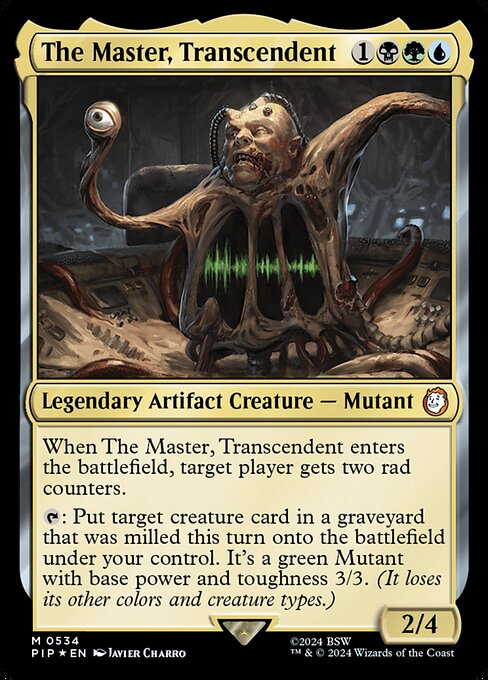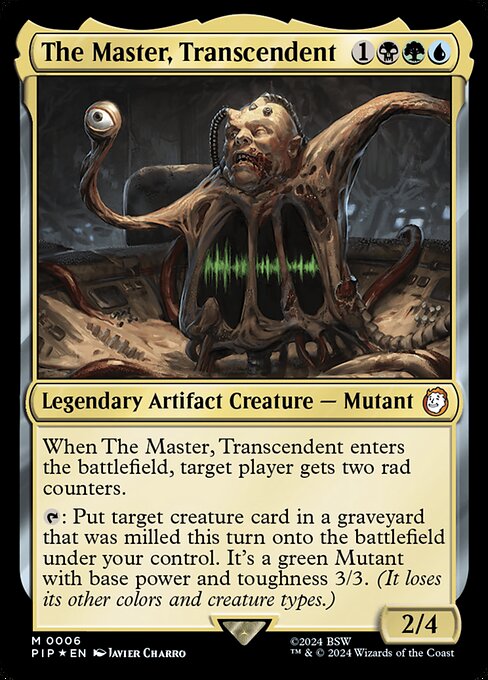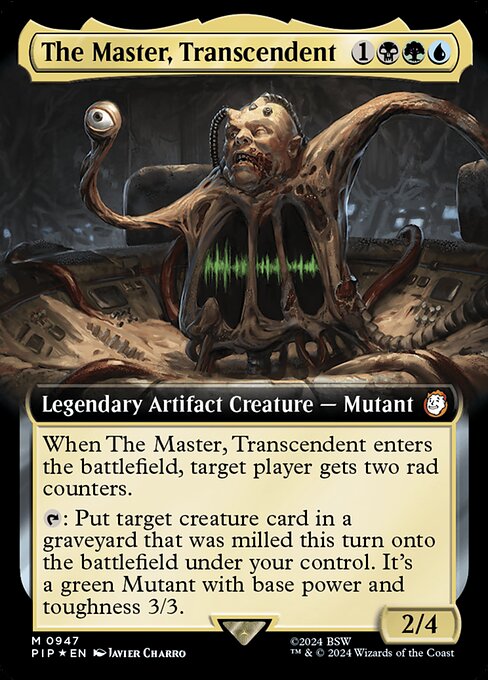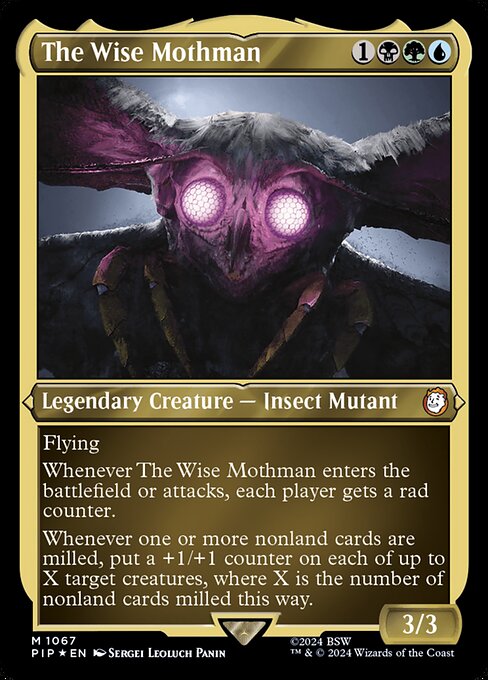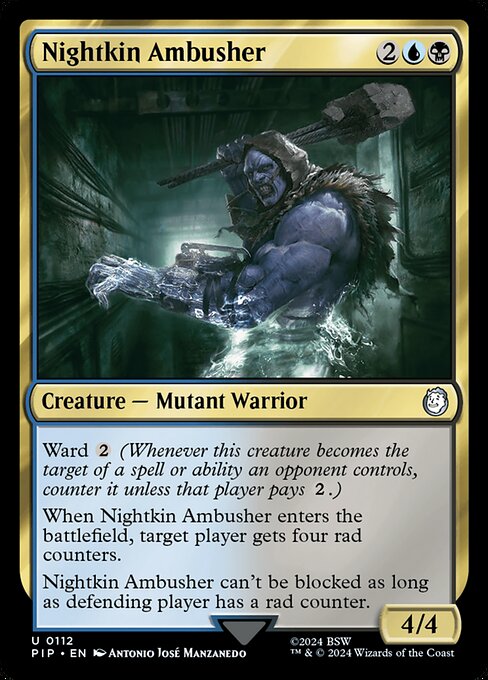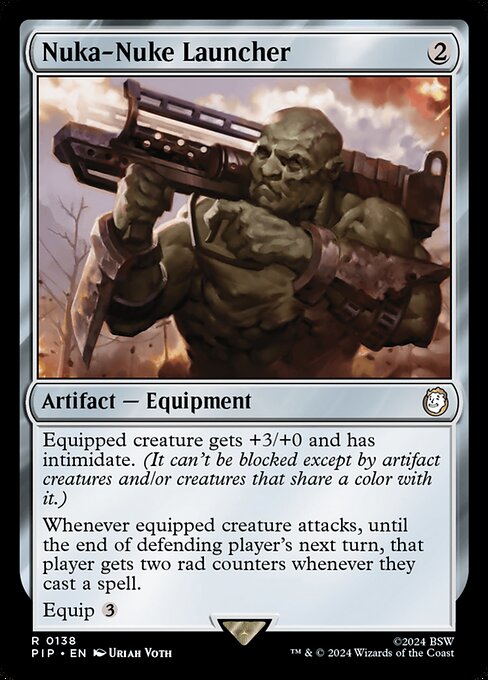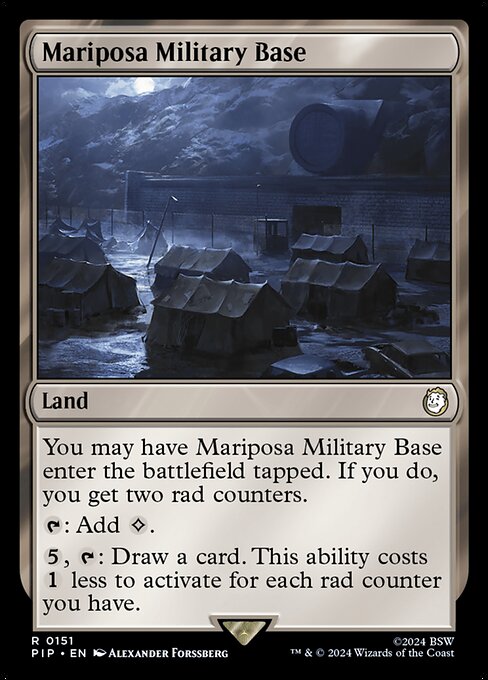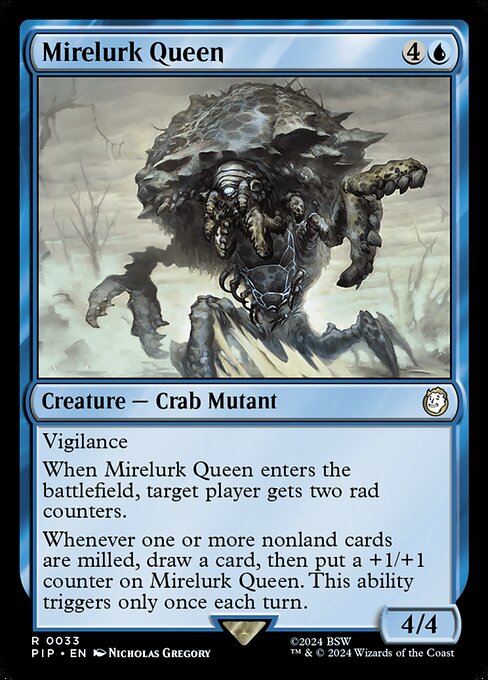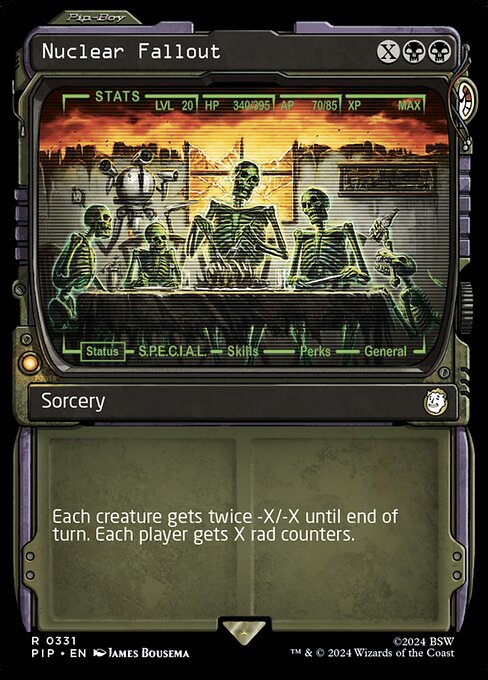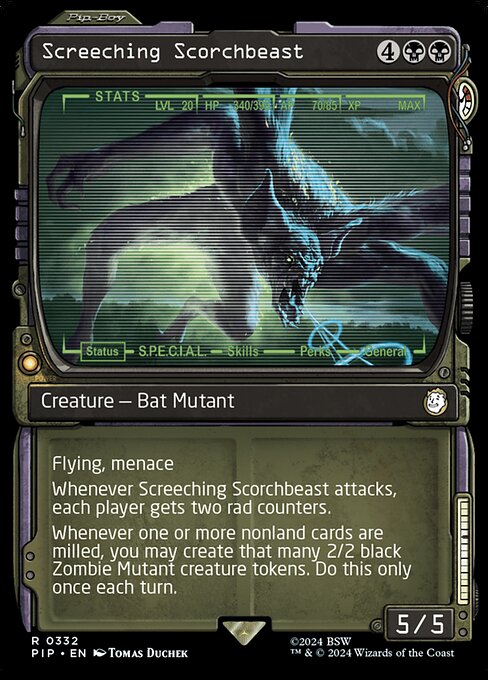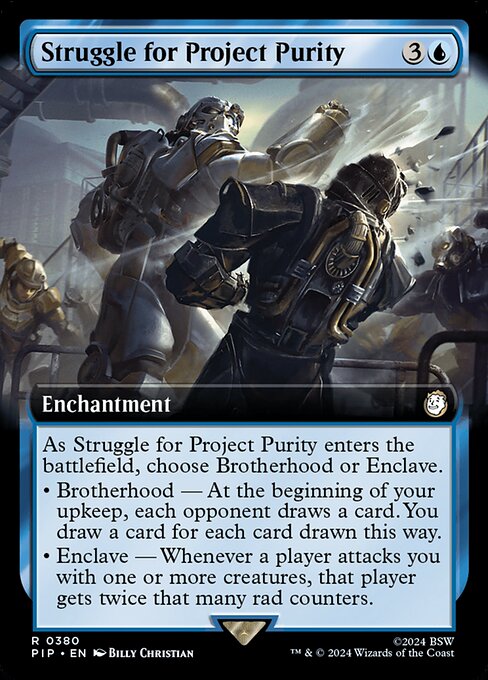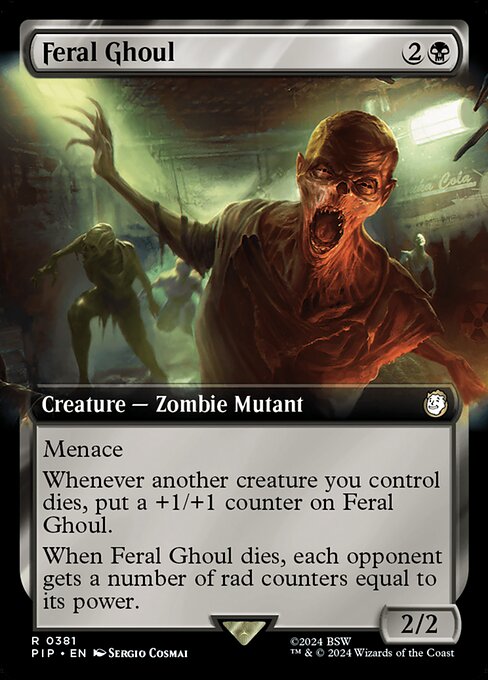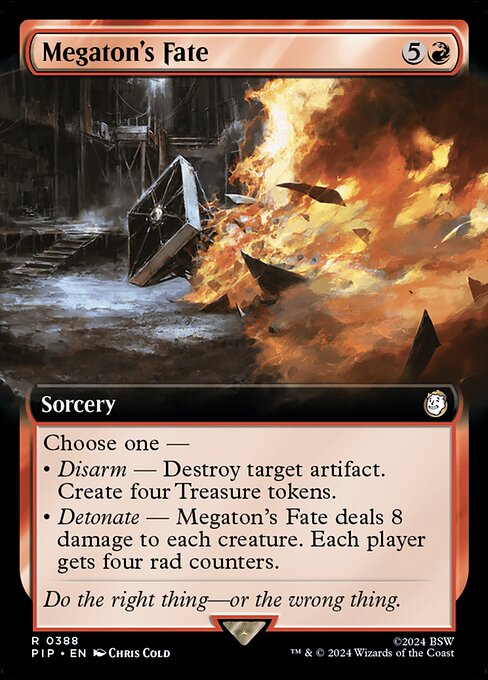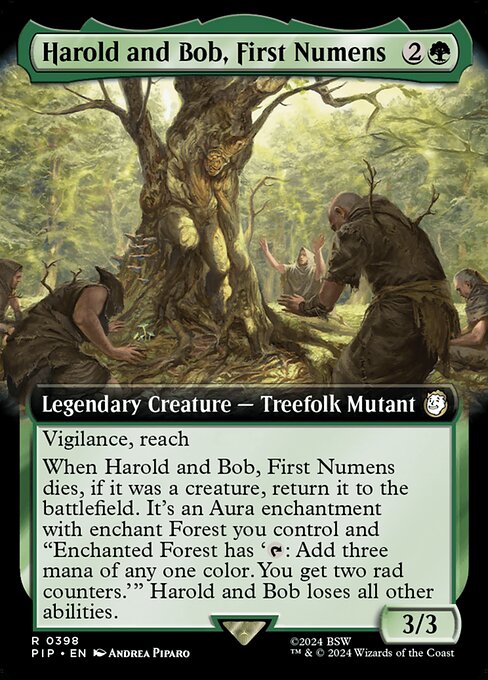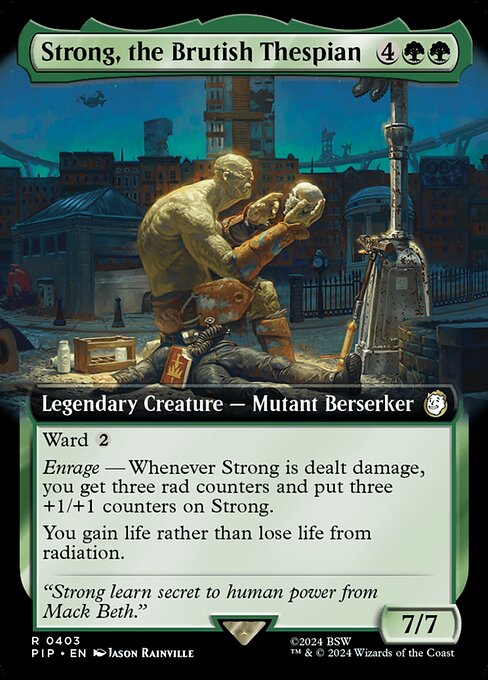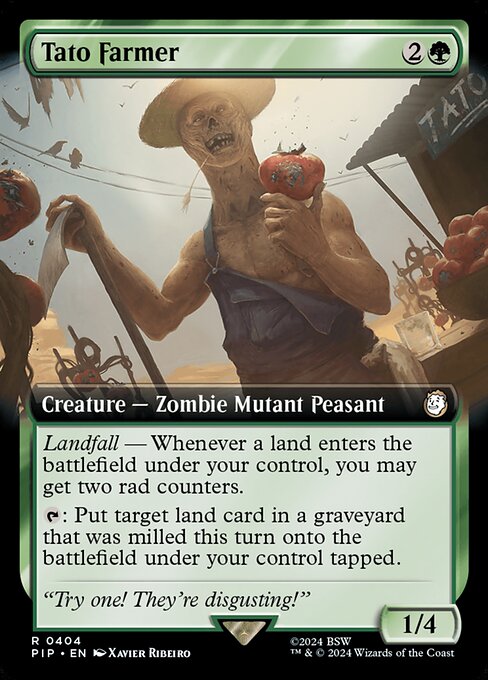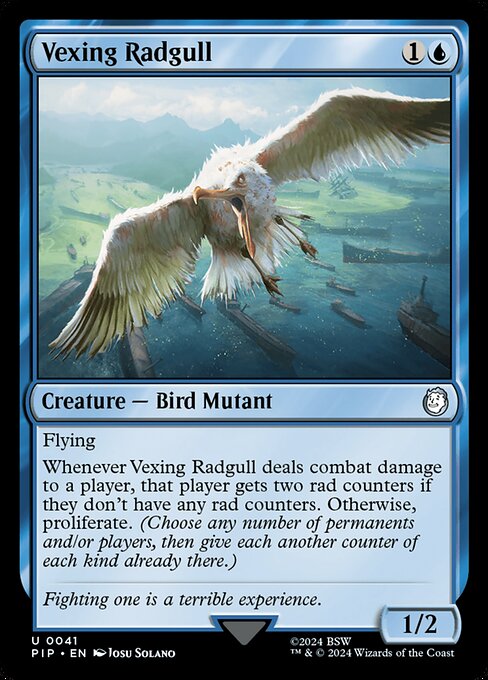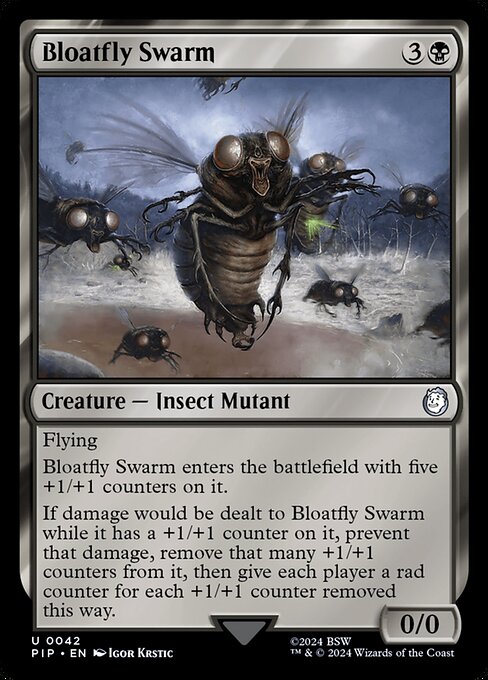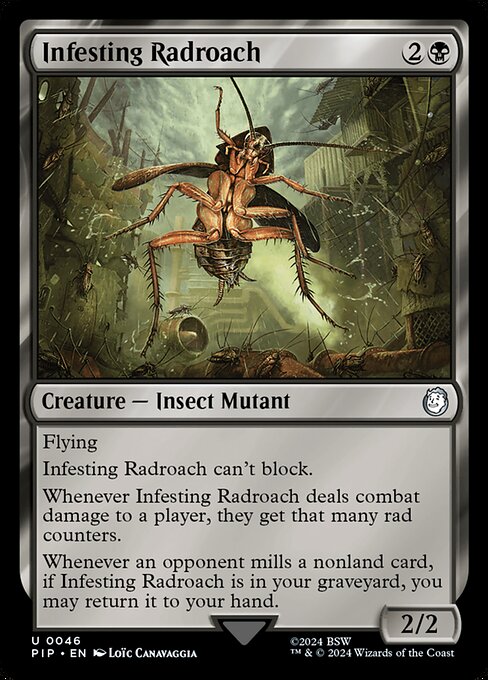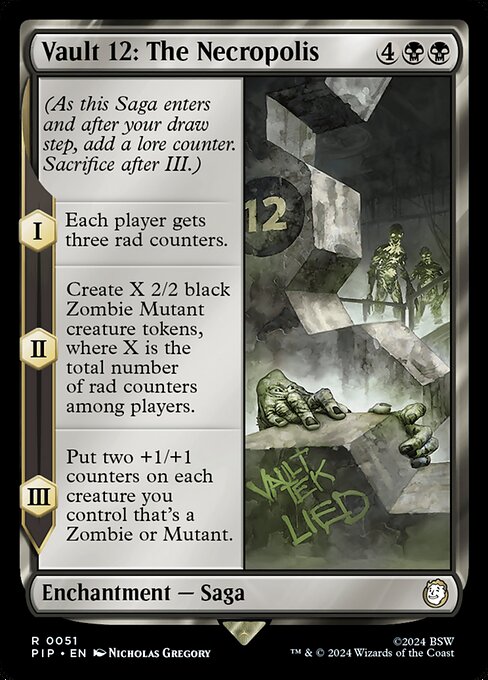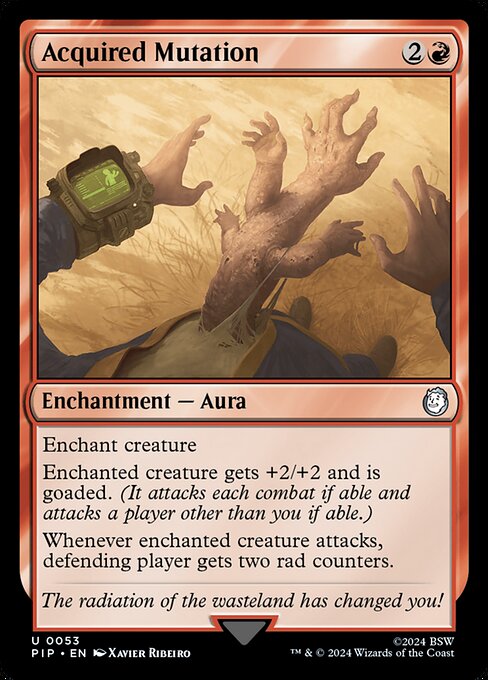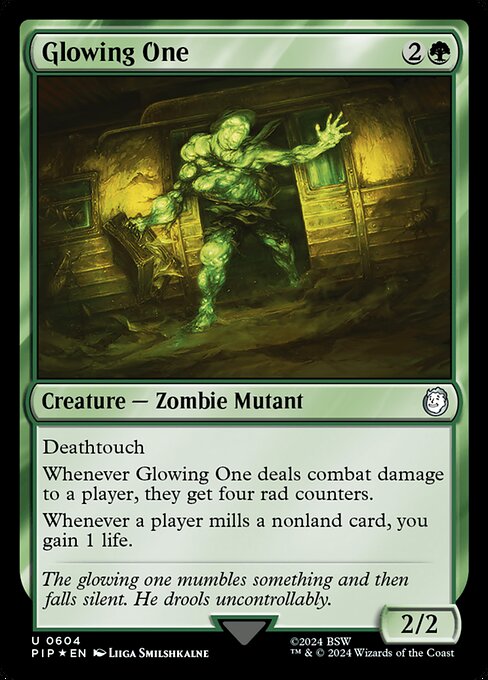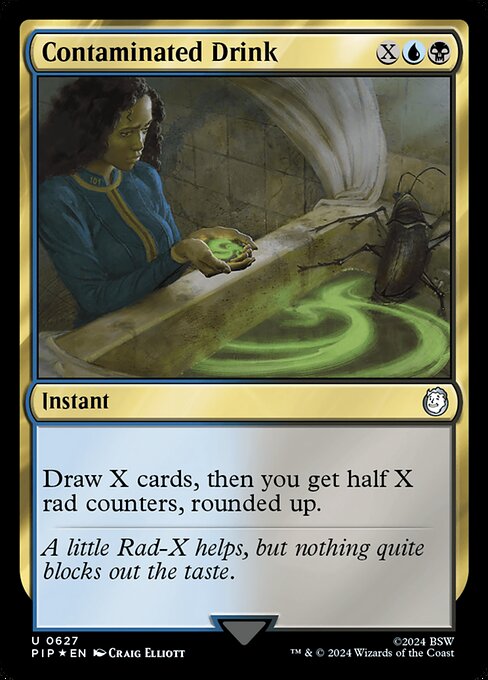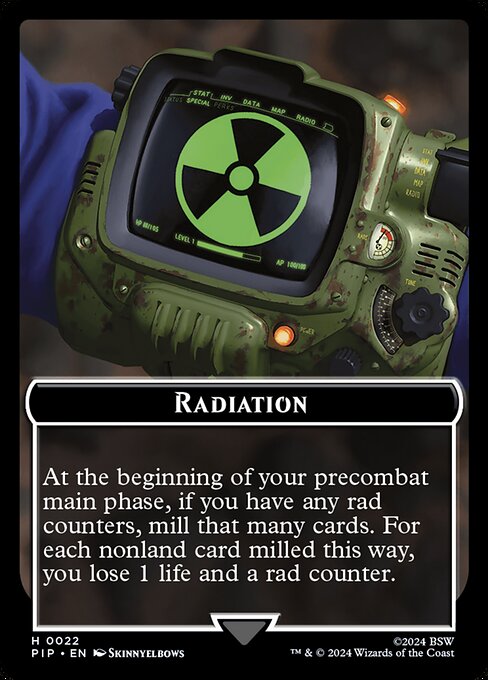The Master, Transcendent
Legendary Artifact Creature — Mutant
When The Master, Transcendent enters the battlefield, target player gets two rad counters.
: Put target creature card in a graveyard that was milled this turn onto the battlefield under your control. It's a green Mutant with base power and toughness 3/3. (It loses its other colors and creature types.)
: Put target creature card in a graveyard that was milled this turn onto the battlefield under your control. It's a green Mutant with base power and toughness 3/3. (It loses its other colors and creature types.)
2/4
standard
future
historic
gladiator
pioneer
explorer
modern
legacy
pauper
vintage
penny
commander
brawl
alchemy
paupercommander
duel
oldschool
premodern
Rulings
In a game using the shared team turns option, such as an Archenemy or Two-Headed Giant game, the inherent triggered ability associated with rad counters triggers once for each player on the active team that has rad counters. Each instance of that ability is controlled by one of those players.
Rad counters don’t go away as steps, phases, or turns end. They only go away when an effect instructs a player to remove rad counters from themselves.
If a player is instructed to put a card into their graveyard from their library without using the word “mill,” (by the effect of Rowan’s Grim Search from Wilds of Eldraine®, for example), that card isn’t a legal target for The Master’s last ability.
If a player has fewer cards remaining in their library than the number of rad counters they have when the triggered ability resolves, they’ll mill as many cards as they can.
Any effects (such as proliferate) that interact with counters a player gets, has, or loses can interact with rad counters.
Effects that modify a creature’s power and/or toughness will still apply to the creature as normal. The same is true for any counters that change its power and/or toughness.
Rad counters are a kind of counter that a player may have. They’re not associated with any specific permanents.
There is an inherent triggered ability associated with having rad counters. This triggered ability has no source and is controlled by the active player. The full text of this ability is “At the beginning of the precombat main phase of a player with rad counters, that player mills cards equal to the number of rad counters they have. For each nonland card milled this way, that player loses 1 life and removes one rad counter from themselves.”
Keep track of how many rad counters each player has. Potential ways to track this include writing them down on paper or using dice, but any method that is clear and mutually agreeable is fine.
The cards are milled all at once, which means abilities that trigger “whenever one or more nonland cards are milled” will trigger exactly once as long as at least one nonland card was milled.
The Master’s last ability will override any characteristic-defining abilities the creature has that set its power and/or toughness. For example, if you put a Robobrain War Mind onto the battlefield with The Master’s last ability, its base power and toughness will be 3/3, and the number of cards in your hand won’t affect its power at all.
Rad counters don’t go away as steps, phases, or turns end. They only go away when an effect instructs a player to remove rad counters from themselves.
If a player is instructed to put a card into their graveyard from their library without using the word “mill,” (by the effect of Rowan’s Grim Search from Wilds of Eldraine®, for example), that card isn’t a legal target for The Master’s last ability.
If a player has fewer cards remaining in their library than the number of rad counters they have when the triggered ability resolves, they’ll mill as many cards as they can.
Any effects (such as proliferate) that interact with counters a player gets, has, or loses can interact with rad counters.
Effects that modify a creature’s power and/or toughness will still apply to the creature as normal. The same is true for any counters that change its power and/or toughness.
Rad counters are a kind of counter that a player may have. They’re not associated with any specific permanents.
There is an inherent triggered ability associated with having rad counters. This triggered ability has no source and is controlled by the active player. The full text of this ability is “At the beginning of the precombat main phase of a player with rad counters, that player mills cards equal to the number of rad counters they have. For each nonland card milled this way, that player loses 1 life and removes one rad counter from themselves.”
Keep track of how many rad counters each player has. Potential ways to track this include writing them down on paper or using dice, but any method that is clear and mutually agreeable is fine.
The cards are milled all at once, which means abilities that trigger “whenever one or more nonland cards are milled” will trigger exactly once as long as at least one nonland card was milled.
The Master’s last ability will override any characteristic-defining abilities the creature has that set its power and/or toughness. For example, if you put a Robobrain War Mind onto the battlefield with The Master’s last ability, its base power and toughness will be 3/3, and the number of cards in your hand won’t affect its power at all.
Rulings
In a game using the shared team turns option, such as an Archenemy or Two-Headed Giant game, the inherent triggered ability associated with rad counters triggers once for each player on the active team that has rad counters. Each instance of that ability is controlled by one of those players.
Rad counters don’t go away as steps, phases, or turns end. They only go away when an effect instructs a player to remove rad counters from themselves.
If a player is instructed to put a card into their graveyard from their library without using the word “mill,” (by the effect of Rowan’s Grim Search from Wilds of Eldraine®, for example), that card isn’t a legal target for The Master’s last ability.
If a player has fewer cards remaining in their library than the number of rad counters they have when the triggered ability resolves, they’ll mill as many cards as they can.
Any effects (such as proliferate) that interact with counters a player gets, has, or loses can interact with rad counters.
Effects that modify a creature’s power and/or toughness will still apply to the creature as normal. The same is true for any counters that change its power and/or toughness.
Rad counters are a kind of counter that a player may have. They’re not associated with any specific permanents.
There is an inherent triggered ability associated with having rad counters. This triggered ability has no source and is controlled by the active player. The full text of this ability is “At the beginning of the precombat main phase of a player with rad counters, that player mills cards equal to the number of rad counters they have. For each nonland card milled this way, that player loses 1 life and removes one rad counter from themselves.”
Keep track of how many rad counters each player has. Potential ways to track this include writing them down on paper or using dice, but any method that is clear and mutually agreeable is fine.
The cards are milled all at once, which means abilities that trigger “whenever one or more nonland cards are milled” will trigger exactly once as long as at least one nonland card was milled.
The Master’s last ability will override any characteristic-defining abilities the creature has that set its power and/or toughness. For example, if you put a Robobrain War Mind onto the battlefield with The Master’s last ability, its base power and toughness will be 3/3, and the number of cards in your hand won’t affect its power at all.
Rad counters don’t go away as steps, phases, or turns end. They only go away when an effect instructs a player to remove rad counters from themselves.
If a player is instructed to put a card into their graveyard from their library without using the word “mill,” (by the effect of Rowan’s Grim Search from Wilds of Eldraine®, for example), that card isn’t a legal target for The Master’s last ability.
If a player has fewer cards remaining in their library than the number of rad counters they have when the triggered ability resolves, they’ll mill as many cards as they can.
Any effects (such as proliferate) that interact with counters a player gets, has, or loses can interact with rad counters.
Effects that modify a creature’s power and/or toughness will still apply to the creature as normal. The same is true for any counters that change its power and/or toughness.
Rad counters are a kind of counter that a player may have. They’re not associated with any specific permanents.
There is an inherent triggered ability associated with having rad counters. This triggered ability has no source and is controlled by the active player. The full text of this ability is “At the beginning of the precombat main phase of a player with rad counters, that player mills cards equal to the number of rad counters they have. For each nonland card milled this way, that player loses 1 life and removes one rad counter from themselves.”
Keep track of how many rad counters each player has. Potential ways to track this include writing them down on paper or using dice, but any method that is clear and mutually agreeable is fine.
The cards are milled all at once, which means abilities that trigger “whenever one or more nonland cards are milled” will trigger exactly once as long as at least one nonland card was milled.
The Master’s last ability will override any characteristic-defining abilities the creature has that set its power and/or toughness. For example, if you put a Robobrain War Mind onto the battlefield with The Master’s last ability, its base power and toughness will be 3/3, and the number of cards in your hand won’t affect its power at all.
Votre collection ? vos decks ?
Envie de gérer votre collection et/ou créer des decks ?
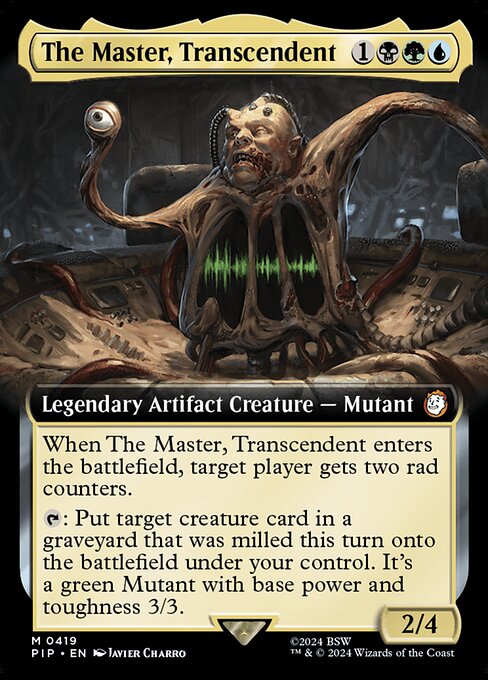

 0
0
 €
€
